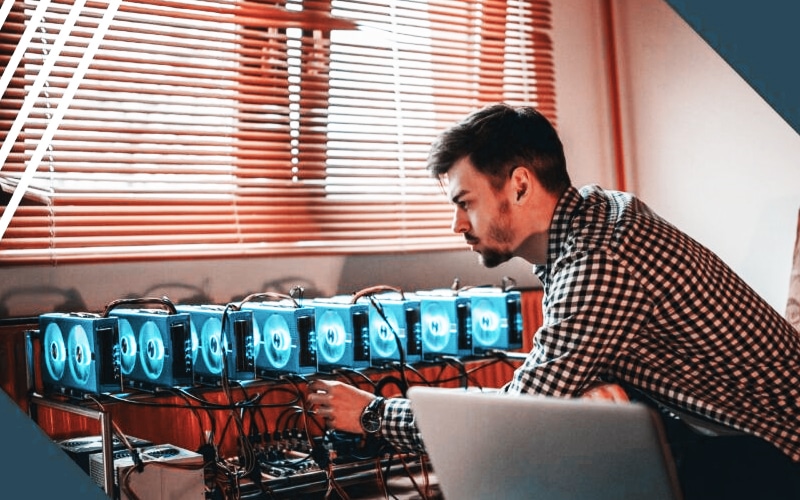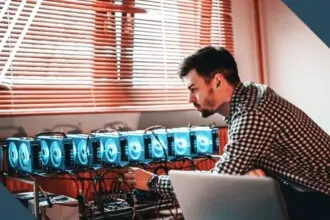It is no surprise that the cryptocurrency market has experienced such rapid growth in recent years, as it is providing another layer of networking to this industry. If you want to capitalize on this crypto uptrend, you can check out Bitprofit to get an automated trading experience by accessing the best-in-class trading bots and strategies.
In particular, blockchain technology provides a means for anyone with access to the internet to contribute processing power towards verifying transaction data and earning cryptocurrency rewards for doing so.
The demand for crypto mining has grown exponentially, with higher initial valuations than any other business class or model. This surge in demand for mining products that make up cryptocurrency algorithms has created a niche market alongside traditional manufacturing industries such as semiconductor and computer chip production.
The rise in demand has led to the creation of crypto mining equipment producers, where consumers are provided with systems and services that help them mine cryptocurrency.
It is important to note that these systems involve various storage mechanisms, such as hard drives, flash drives, and other similar devices, used to store the data generated by miners. Let’s discuss everything you must have to start cryptocurrency mining.
Also Read: Michael Saylor Advocates Bitcoin Mining Against Critics
Bitcoin Mining Hardware:
When it comes to crypto mining, the first thing you will need is fixed hardware. Hardware refers to a system created specifically for cryptocurrency mining, including your computer’s CPU, GPU, or ASIC. The cryptocurrency mining software that runs on this hardware is created to carry out complex mathematical calculations required for creating new coins within a currency blockchain. The main types of hardware used in cryptocurrency mining are:
CPUs (Central Processing Units):
CPUs have existed since the eighties and provide conventional computing power for computers. People used them before GPUs were developed. In fact, crypto mining was originally performed using CPUs. However, the CPU-based mining approach was ineffective as it has limited processing speed and high power consumption. Thus, crypto miners shifted to GPU-based mining that offered multiple benefits over the use of CPUs.
GPU:
These graphics processing units with an integrated video card and a dedicated processor to help speed up the images they are processing. Sometimes consumers will use their old computer to mine, install the crypto mining software and run it on the system’s graphics card.
It is over 800 times more than the speed of a CPU that executed only 4 32-bit instructions per clock. On the other hand, the GPU is capable of executing 3,200 32-bit instructions per clock.
Cryptocurrency mining is one of the prominent reasons why the market value of GPUs has been on the roof lately.
ASIC:
ASIC stands for Application-Specific Integrated Circuit. These are high-performance computers specifically designed for cryptocurrency mining. They get their power from a combination of analogue and digital circuits, which help them carry out cryptojacking and use6 computing power to mine for cryptocurrency. ASIC produces 100 trillion hashes per second and this measures to a 125,000-fold difference as compared to GPUs.
The ASIC is also highly efficient and can be found in industrial components such as routers. However, so far, the sole purpose of ASICs is bitcoin or cryptocurrency mining.
Bitcoin Mining Software:
After you have purchased your crypto mining hardware, you will need to configure the software onto it. The software serves as a platform to run your mining algorithms. It is usually command-line-based and configures the computer resources used for mining.
Once the mining software is installed on the system and powered up, it will take care of all calculations required for cryptocurrency mining, including keeping track of each transaction’s integrity, validating them, and sharing them with the network to be added to the blockchain.
You can either choose from essential software that connects your computer with a pool of other miners, or you can go for a more advanced version that tracks each transaction and records it in a log for future reference.
A Cheap Power Supply:
It is probably the most overlooked part of a cryptocurrency mining rig. No matter how much time you put into keeping your hardware cool, it will become useless if the power supply is weak.
So it would be best to have a high output power supply that can provide at least 1600W of continuous power and must generate enough amperes to supply all your mining devices, whether GPUs or ASIC. A mining rig can consist of a CPU, GPU, or ASICs with each having a different price, size, scale, and efficiency.
A mining rig with a power supply that cannot keep up with the rest of it will not be able to produce earnings which may result in lost investments. The difference between having high-capacity cables and low-capacity ones is massive. They determine how much electricity you can receive in your system.
Also Read: Kenya’s KenGen to Offer Clean Energy to Bitcoin Miners
Bitcoin Mining Pools:
The main reason you want to mine in a pool is that it enables you to get a steady stream of income by sharing block rewards with other miners when you solve a hash algorithm and secure network transactions instead of taking all the proceeds from your efforts when mining solo.







